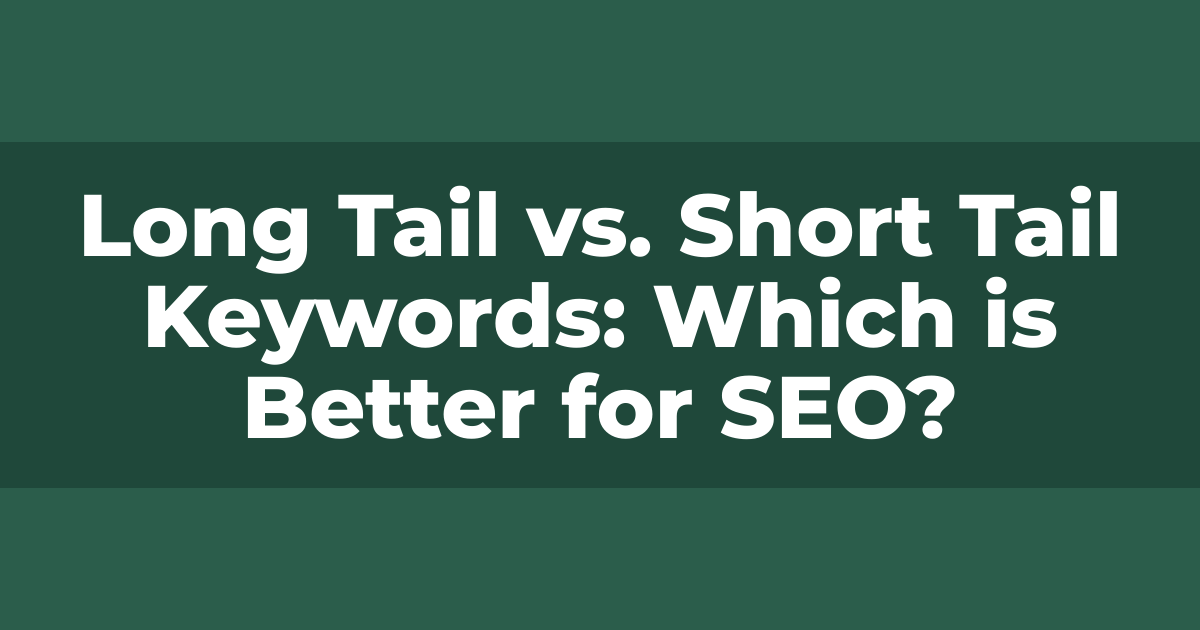In the world of SEO, the debate between long and short-tail keywords has been ongoing for years. Both types of keywords have advantages and disadvantages, and choosing the right keyword for your website can make a huge difference in your search engine rankings.
So, what are long-tail and short-tail keywords, and why is keyword research so important for SEO?
A Brief Explainer
Short tail keywords are brief and general search terms typically consisting of one or two words. For example, “shoes” or “marketing” are short-tail keywords. On the other hand, long tail keywords are longer, more specific phrases typically made up of three or more words, such as “women’s running shoes” or “digital marketing agency in New York.”
Keyword research is finding the right keywords to target for your website so that when people search for those keywords, your site appears at the top of the search engine results page. This is critical for driving traffic to your site, increasing visibility, and boosting your sales or leads.
So, which type of keyword is better for SEO?
In this blog post, we’ll explore the differences between long-tail and short-tail keywords and discuss the pros and cons of each type. We’ll also provide tips on finding long-tail keywords and help you determine which type is best for your SEO strategy. Let’s dive in!
What are Short Tail Keywords?
Short tail keywords, or head keywords, are typically brief, broad search terms that consist of one or two words.
They are commonly used by search engine users in the early stages of their search, trying to get a general idea of a topic.
Examples of short tail keywords include “shoes,” “SEO,” “books,” and “travel.”
Advantages of using short tail keywords
- High search volume: Short-tail keywords have a high search volume, meaning that they are searched for more frequently than long-tail keywords. This makes them attractive to businesses because they have the potential to generate a large amount of traffic to their website.
- Easier to optimize: Short-tail keywords are easier to optimize because they are less specific than long-tail keywords. It is easier to incorporate them into website content and meta tags, making them more visible to search engines.
Disadvantages of using short tail keywords
- High competition: Short-tail keywords are highly competitive due to their high search volume. This means it can be difficult for businesses to rank for these keywords, as more significant, established companies often target them.
- Lower conversion rates: Short-tail keywords may generate a lot of traffic to a website, but they often have lower conversion rates. This is because they are less specific, and the user’s intent may not match what the website offers. This can result in a high bounce rate, meaning users leave the site quickly without engaging further.
Summing up, while short-tail keywords can generate a high volume of traffic to a website, they can be challenging to rank for and may result in lower conversion rates. Businesses need to consider the specific needs of their target audience when learning how to find keywords to target in their SEO strategy. You can use keyword suggestions and search queries to find short tail keywords.
What are Long Tail Keywords?
Long tail keywords are longer, more specific search phrases that typically contain three or more words.
They are often used by search engine users looking for something particular with clear intent.
Examples of long tail keyword searches include “women’s running shoes for flat feet,” “affordable SEO services for emerging businesses,” and “best beach resorts in Bali for families.
Advantages of using long-tail keywords
- Low competition: Long tail keywords are less competitive than short tail keywords, making ranking them easier. This is because they are more specific and targeted toward a particular audience, attracting fewer competitors.
- Higher conversion rates: Long tail keywords have a higher conversion rate because they are more specific and targeted toward the user’s intent. When a user searches for a long tail keyword, they are often closer to making a purchase decision or taking a specific action, making them more valuable to businesses.
Disadvantages of using long-tail keywords:
- Low search volume: Long tail keywords have a lower search volume than short tail keywords, meaning they are searched for less frequently. This can make it challenging for businesses to generate a large amount of traffic to their website.
- Time-consuming to research: Finding the right long tail keywords can be time-consuming. Businesses need to conduct thorough keyword research and analysis to identify relevant and effective long-tail keywords to target.
While long-tail keywords may have lower search volume, they can result in higher conversion rates and lower competition. For businesses with a specific target audience, long-tail keywords can effectively generate targeted traffic to their website and increase their chances of converting those visitors into customers.
Differences between long-tail keywords and short-tail keywords
Now let us look at both the keyword types side by side:
- Length: Short tail keywords are brief, typically one or two words, while long tail keywords are longer, consisting of three or more words.
- Specificity: Short tail keywords are more general and less specific, while long tail keywords are more specific and targeted towards a particular audience.
- Search volume: Short tail keywords have a higher search volume than long tail keywords, meaning they are searched for more frequently, while long tail keywords have a lower search volume.
- Competition: Short-tail keywords have higher competition, while long-tail keywords have lower competition.
Which type of keyword is better for SEO?
There is no one-size-fits-all answer to this question, as the best type of keyword for SEO will depend on various factors, including the specific needs of your target audience and the goals of your SEO strategy.
Long-tail and short-tail keywords have advantages and disadvantages, and businesses should consider both types of keywords in their SEO strategy.
Short tail keywords may be more suitable for businesses that want to generate a high traffic volume to their website. Long-tail keywords may be more suitable for businesses that want to generate targeted traffic and increase their chances of converting visitors into customers.
Ultimately, a balanced approach targeting both keywords may be the most effective for SEO.
How to find Long Tail Keywords?
Finding long-tail keywords is an integral part of SEO, but it can be challenging to identify the right keywords to target.
Here are some tools and strategies to help you discover long-tail keywords:
Tools for finding long tail keywords
- Google Keyword Planner: This free tool from Google allows you to research keywords and get ideas for new keywords based on your initial search terms.
- SEMrush: A popular keyword research tool that offers advanced features and in-depth analysis of keyword data.
- Ahrefs: Another comprehensive keyword research tool that provides detailed insights into keyword search volume, competition, and difficulty.
Strategies for discovering long tail keywords
- Use Google Autocomplete: Start typing a keyword or phrase into Google search, and it will provide you with a list of suggested searches based on what other people are searching for.
- Look at related searches: You’ll find a list of related searches at the bottom of the Google search results page. These can be a great source of inspiration for long-tail keywords.
- Analyze your website data: Use your website’s analytics data to identify which long-tail keywords already bring traffic to your site. You can then optimize your content around those keywords to improve your rankings.
- Look at competitor’s keywords: Use tools like SEMrush or Ahrefs to analyze your competitors’ websites and identify the long tail keywords they are targeting. This can give you ideas for keywords that you may have overlooked.
Finding the right long-tail keywords requires research tools and strategic thinking. Using the tools and strategies above, you can identify high-quality long-tail keywords that will help you attract targeted traffic to your website and improve your search engine rankings.
Frequently Asked Questions
What is the difference between long-tail and short-tail keywords?
Long tail keywords are specific and targeted keyword phrases that contain three or more words, while short tail keywords are more general and usually consist of one or two words.
What are the advantages of using short-tail keywords?
Short tail keywords have higher search volumes, are easier to optimize, and can generate a high traffic volume to a website.
What are the advantages of using long-tail keywords?
Long tail keywords have lower competition, higher conversion rates, and can attract more targeted traffic to a website.
What are the disadvantages of using short-tail keywords?
Short-tail keywords have higher competition, lower conversion rates, and can be less specific and targeted, making it harder to attract the right audience.
What are the disadvantages of using long-tail keywords?
Long-tail keywords have lower search volumes, can be time-consuming to research, and may not generate as much traffic to a website as short-tail keywords.
Conclusion
Both long and short-tail keywords have advantages and disadvantages regarding SEO.
Short tail keywords are more general, have higher search volumes, and are easier to optimize, but they also have higher competition and lower conversion rates.
Long tail keywords are more specific, have lower competition, and have higher conversion rates, but they also have lower search volumes and can be time-consuming to research.




















